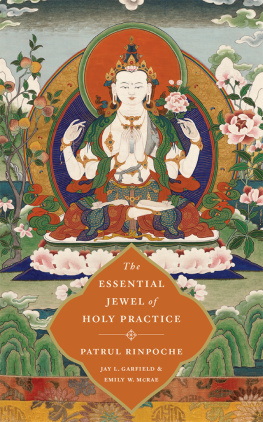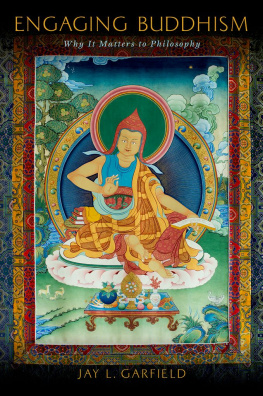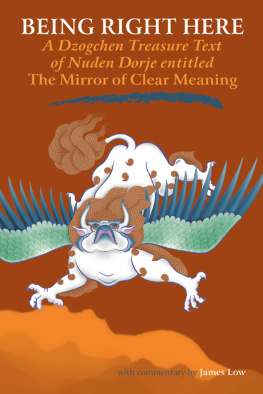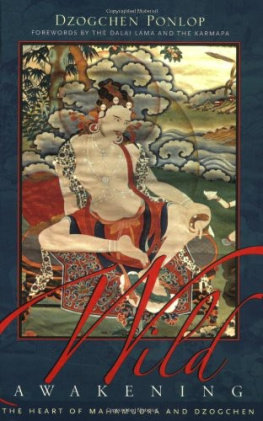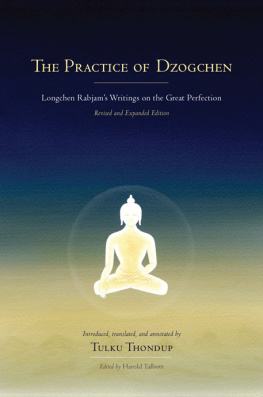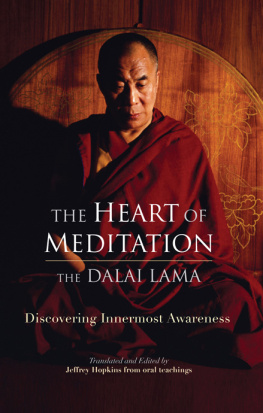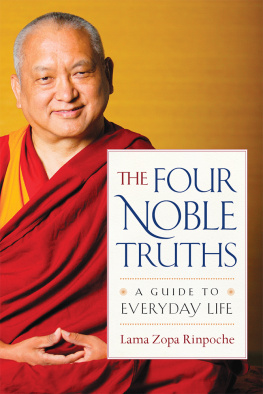Praise for
THE ESSENTIAL JEWEL
OF HOLY PRACTICE
Here, translated into very accessible English, beautifully presented in a spacious edition appropriate to the expansive Dzogchen doctrine, is Patrul Rinpoches summary of the path of integrated practice for an authentic compassionate practitioner. It is a moving and transcendent vision of Buddhism uniting wisdom, care for others, and mantra.
GARETH SPARHAM,
translator of Vast as the Heavens, Deep as the Sea
Patrul Rinpoches Essential Jewel is a treasure trove packed with wisdom and skillful means for all levels of Buddhist practice. Garfield and McRae here offer a fresh translation of Patruls song of instruction, presented in a bilingual format and accompanied by their novel, Madhyamaka-inspired interpretation of the nature and origins of Vajrayana and Dzogchen. The blessings of the six-beat mantra are sure to bring awakening in our hearts!
THOMAS DOCTOR,
research scholar, Rangjung Yeshe Institute
A beautiful and lucid translation of a textual gem by one of Tibets most eloquent teachers. This work offers advice on how to live in the world and cultivate our best potential in light of Buddhist ethics and philosophy.
JANET GYATSO,
Hershey Professor of Buddhist Studies, Harvard University
Dza Patrul Rinpoche was a humble monk and erudite scholar who dedicated himself to practicing what is taught in antidevas How to Lead an Awakened Life... Patrul Rinpoches essential point is that we need to transform ourselves in thought, word, and deed, which requires mindfulness, introspection, and conscientiousness.
HIS HOLINESS THE DALAI LAMA
We dedicate this translation to
all of the Tibetan teachers
who have kept the Buddhadharma and the
great Tibetan lineages alive,
both under occupation and in exile.

FOREWORD BY
His Holiness the Dalai Lama

Dza Patrul Rinpoche was a humble monk and erudite scholar who dedicated himself to practicing what is taught in ntidevas How to Lead an Awakened Life (Bodhicaryvatra), the transmission and explanation of which I received in this lineage from Khunu Lama Rinpoche. The essential point of it is that we need to transform ourselves in thought, word, and deed, which requires mindfulness, introspection, and conscientiousness.
His Essential Jewel of Holy Practice, which I like for its direct, down-to-earth style, was explained to me by Dilgo Khyentse Rinpoche. It begins with a salutation to the Three Jewels. It touches on how to turn away from the preoccupations of this life. It explains how to overcome the misconception of self and alludes to guru yoga in stating that the ultimate lama is the innate mind of clear light. It mentions that some Mdhyamikas allow that things have some objective existence, whereas the Prsagika Mdhyamikas state that although there is appeareance, there is no independent objective existence whatever. The text goes on to distinguish the views of sutra and tantra as being differentiated not in terms of their object but in terms of the subjective perspective. Lines close to the end summarize the teachingIf you examine your mind continuously, whatever you do, you are following the perfect path.
I congratulate Jay Garfield and Emily McRae on making this fresh English translation in which they have tried to reflect the simple but profound meaning of Patrul Rinpoches advice. It will appeal especially to readers who seek a succinct rendition of all the essential instructions of the bodhisattva path.
The Dalai Lama

INTRODUCTION TO
The Essential Jewel of Holy Practice
by Patrul Rinpoche

JAY L. GARFIELD, EMILY W. MCRAE
PATRUL RINPOCHE
Orgyen Jigme Chokyi Wangpo, better known as Patrul Rinpoche, was one of the most influential philosophers and meditation masters of nineteenth-century Tibet. He was an adept of the Dzogchen (Great Perfection) tradition associated with the Nyingma school and a scholar of both Madhyamaka philosophy and tantra. Patrul Rinpoche is the author of many influential and widely read texts, including his classic introduction to and synopsis of the Buddhist path, The Words of My Perfect Teacher. He was also renowned as a meditator and Dzogchen practitioner.
Patrul Rinpoches prose and poetry is profound, philosophically precise, eloquent, and yet completely accessible to advanced scholars and practitioners as well as to laypeople and novices. As one of his disciples noted, even if his teachings are heard by a dull mind, still they are easy to understand (Thondup, 209). The text we present here, The Essential Jewel of Holy Practice, conveys in lucid and evocative poetry the subtlest aspects of the phenomenology of liberation and the relationship between Buddhist philosophical tenets, the practice of the path to awakening, and the cultivation of moral sensitivity. Patrul Rinpoche speaks directly and powerfully, but intimately, to the reader without alienating her; the intimacy he achieves only enhances the readers connection to the text. Another great Dzogchen master of that time, the third Dodrupchen, wrote: Patrul uses fearful and overwhelmingly tough words, but there is no trace of hatred or attachment in them. If you know how to listen to them, they are directly or indirectly only teachings. Whatever he says is solid like goldit is true (Thondup, 208).
Patrul Rinpoche was born in eastern Tibet in 1808. His spiritual biography (in the hagiographic style characteristic of this Tibetan genre) reports that he chanted the syllable o immediately after he was born and clearly recited the full Avalokitevara mantrao mai padme hwhen he was only five days old. This mantra, to which he refers in the present text as the six-beat mantra (yig drug), had special significance for Patrul Rinpoche. Most Tibetans believe that reciting this mantra develops the attitude of universal care embodied by the celestial bodhisattva Avalokitevara. Patrul Rinpoche is credited with disseminating the practice of regularly reciting this mantra, and hence with emphasizing the importance of the cultivation of an attitude of care in daily practice among the laypeople of eastern Tibet. The advice to chant the six-beat mantra is repeated over twenty times in TheEssential Jewel of Holy Practice. The associated development of an altruistic attitude of universal care (karu) and the aspiration to attain awakening for the benefit of all beings (bodhicitta) was at the heart of many of Patrul Rinpoches teachings. One of his daily practices was to chant ntidevas How to Lead an Awakened Life (Bodhicaryvatra), a text that he taught frequently and on which he composed an influential commentary.
Patrul Rinpoche was a Dzogchen master. In the Dzogchen tradition, the recognition of the nature of mind requires the assistance of a teacher who will indicate or introduce the disciple to the nature of her own mind. Sometimes these indication instructions employ unconventional methods, as in Patrul Rinpoches case. According to his biography, one day when Patrul Rinpoche was meditating in his hermitage, one of his root teachers, Do Khyentse, visited him. When Patrul Rinpoche went out to greet him, Do Khyentse grabbed him by the hair and dragged him around. Patrul Rinpoche smelled alcohol on Do Khyentses breath and thought, The Buddha expounded on the dangers of alcohol, yet even a great adept like him could get drunk like this (Thondup, 202). Do Khyentse immediately released Patrul Rinpoche and spat in his face, shouting, Alas, that you intellectual people have such evil thoughts! You old dog! Patrul Rinpoche was astounded by both his own negative thoughts and his teachers clairvoyance. In that moment, it is reported that Patrul Rinpoche meditated on the enlightened nature of his mind, and a clear, sky-like, open and intrinsic awareness awakened in him. He realized, in other words, the nature of his own mind. In honor of this event, Patrul Rinpoche jokingly took Old Dog as his spiritual name.
Next page
